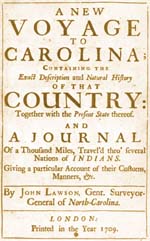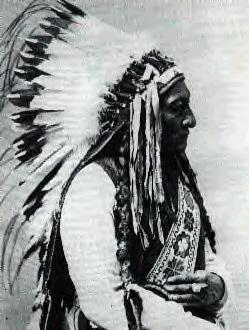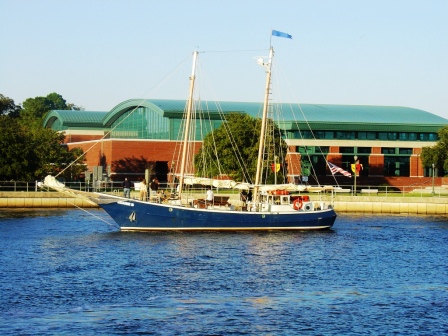
Elizabeth I granted a charter to Sir Walter Raleigh for land in present-day North Carolina. Raleigh established two colonies on the coast in the late 1580s, both eventually ending in failure. It was the second American territory located on Roanoke Island that the British attempted to colonize. The first English child born in the United States was Virginia Dare. She was was born on Roanoke Island August 18,1587. Roanoke Island is located in the Croatan Sound which is in northeastern North Carolina. John White, the settlements leader, and grandfather of Virginia Dare, returned to England to purchase much needed supplies for the Colony. Due to an impending attack of England by Spain he was unable to return for nearly 3 years. When he finally returned the colony had vanished. The Lost Colony remains one of the great mysteries of American history and is unsolved to this day.

A "Carolina Charter" was issued by King Charles II after he was restored to the throne in 1660 granting his loyal supporters and drinking buddies, The Lords Proprietor, wide areas of land in the New World. The Carolina Charter spread from Virginia to the Spanish border of Florida. The name Carolina came from "Carolus,"the Latin word for Charles. William, Earl of Craven, was one of the original Lords Proprietor, and Craven County bears his name. The first Europeans to explore and inhabit the New Bern area migrated south as early as 1690 from Virginia and the Albemarle region of North Eastern N.C. Although few in numbers, they managed to survive in the areas now known as Pamlico County, Carteret County, and Craven County. They were undoubtedly rugged individuals who able to survive by utilizing the local rivers for transportation and fishing. Hunting the bountiful deer and other game native to the area provided early settlers with much needed food.

John Lawson was a English explorer, naturalist, and writer. He was instrumental in the exploration and eventual settlement of New Bern, NC. In 1700, a London botanist and pharmacist, James Petiver, published a notice seeking someone to collect American specimens for him, and Lawson volunteered to do this without charge. Lawson proved to be an unusually keen naturalist. Thirty of the specimens that Lawson sent back to Petiver still survive in the Sloane collection at the British Museum.

On May 1, 1700, Lawson was granted free passage on a ship headed for New York. In August he set sail for Charles Town (now Charleston, S.C.). On Dec. 28th he led a small expedition that consisted of five Englishmen and 4 native American Indians on a 550 mile journey that ended on 24 Feb.,1701 at the Pamlico River in North Carolina. Lawson took many detailed notes describing the wildlife, vegetation, and the many different Indian Tribes he met along the way. His journey ended near the mouth of the Pamlico River, just north of New Bern, where he decided to settle and work as a land surveyor. After remaining briefly along the Pamlico, Lawson built a house on some high ground near a creek, still known as Lawson Creek, about half a mile from the Indian town of Chattoka, now know as New Bern. Chattoka means "where the fish are taken out". In 1705 he was appointed deputy surveyor for the Lords Proprietor of Carolina.

In 1709 Lawson returned to London to oversee the publication of a book he had written about his adventures in Carolina. The book, A New Voyage to Carolina, was widely published and read throughout Europe resulting in many Europeans becoming interested in the land known as Carolina. He also was instrumental in helping Von Graffenreid organize a group of Palatine Germans and Swiss to settle in Carolina. Lawson returned to the new world with Von Graffinreid in 1710 and settled in the area now known as New Bern.
In September, 1711 Lawson and Christopher von Graffenreid were captured by Tuscarora Indians while exploring the Neuse River. They released Von Graffenreid but tortured and killed Lawson. Shortly thereafter, tensions between Indians and settlers erupted into a bloody conflict known as the Tuscarora War.

Christoph Von Graffenreid (1661-1743) was born in the canton of Bern Switzerland. Von Graffenreid studied at the Universities of Heidelberg and Leyden. When he was 41 years he became acquainted with the explorer-adventurer Franz Ludwig Michel who persuaded him to join and invest in the Georg Ritter Company, a venture that proposed to mine American silver deposits and to settle indigent Swiss in America. Graffenried's influence appears to have overshadowed that of Ritter and under his leadership the company broadened its plans to settle the colonists in the Province of Carolina and to include among the settler's many of the distressed victims of the War of the Spanish Succession, the "poor Palatines" whom the English had transported from the devastated Rhineland to refugee camps on the Thames River. Palatines.
The Ritter company purchased from the Lords Proprietors nearly 19,000 acres of land on the Neuse and Trent rivers. Graffenreid departed England in 1710 with 150 Swiss passengers and 650 Palatines. Among the passengers was John Lawson who had promised to show them the way to land that would be suited to begin their new colony. On the way over they were attacked by French pirate's who stole many of their needed supplies. Many of the Palatines died of disease crossing the ocean. The new settlement called New Bern was hampered from the start due to poor planning, inadequate capital, yellow fever and dubious leadership. Graffenreid ran into financial problems and was forced to sell most of his land to Col. Thomas Pollock, a wealthy landowner and future Governor of North Carolina from 1712-1714.

In September of 1711 Tuscarora Indians, fed up with the treatment they had received from the white men attacked the settlement and destroyed crops, houses, and livestock and killed sixty some English settlers and as many Swiss and Palatines. The attacks continued and eventually forced the colonist to abandon the site at New Bern and build a fortified settlement about 20 miles west of New Bern. Col. John Barnwell of South Carolina was ordered to lead a small army of soldiers and friendly Indians to the aid of the colonist. Together he and later Col. James Moore managed to defeat the Tuscaroras and forced many of them to leave and relocate to New York. Unfortunately, a neighboring tribe, the Coree, continued attacking New Bern until 1718. The continued attacks eventually forced most of the settlers to abandon New Bern and the area remained virtually uninhabited until the late 1720's.
Col. Pollock, having purchased most of Graffinreid's land holdings in 1711 including all of New Bern, started selling lots in New Bern in 1720. Settlers slowly started to move back into town. At this time the only parts of North Carolina that were populated to any degree were the coastal regions, primarily to the south around the Cape Fear River (Wilmington) and to the north around the Albemarle Sound. New Bern being centrally located between the two larger regions, became one of the meeting places for the colonial assembly in 1737.

In 1754 Governor Dobbs established his residence in New Bern and all sessions of the assembly were held in New Bern during his four year stay. This acted as a stimulus for trade and commerce and a boom in building. Governor Dobbs moved to Wilmington after 4 years and with him moved the assembly. The Colonial Assembly passed an act in 1749 to appoint a public printer. James Davis came down from Virginia to take the job. In 1751, Davis began printing the North Carolina Gazette, the first newspaper to be printed in the colony. The presence of the newspaper did much to enhance the reputation of New Bern as a growing town, and Davis argued frequently that New Bern should be declared the capital of the colony.

The year 1765 proved to be an important one for New Bern. Governor Dobbs died, and his replacement Governor William Tryon, found New Bern to be conveniently located and had legislation passed that year declaring New Bern to be the permanent capital of the colony. Money was appropriated for the construction of combined capital and governors mansion. Started in 1767 and completed in 1770 this building was one of the finest structures in all of the colonies. New Bern was quickly becoming an important port and trade center. The bulk of the trade activity was directed towards exporting the various natural resources of the region, including timber, navel stores, and agriculture.
Although not actively involved in the Revolutionary War the town did make a contribution by way of local privateers whose vessels raided and harassed British ships throughout the Carolina waterways. The British quietly took New Bern in 1781 but spared it from any major damage.
After the revolution, New Bern was flourishing and developed a rich cultural life. In fact, at one time New Bern was called " The Athens of the South. " Even though the capital was moved to Raleigh in 1792 it did not curb the growth in New Bern. By 1800 New Bern was by far the largest town in North Carolina. Growth continued during the first two decades of the nineteenth century but at a slower pace than was experienced in the past four decades. Commerce and growth in New Bern came to an abrupt halt around 1835. Trading activity was diminishing as commercial ships started experiencing difficulty passing through Ocracoke Inlet and the Pamlico Sound on their journey to New Bern. As a result, by 1840, Wilmington, with its deeper waterways and recently completed railroad to Raleigh, had become the state's primarily port.
The years 1840-1849 brought about a gradual improvement to New Bern's struggling economy. The nation's growing appetite for the area's principle products which included turpentine, navel stores, and lumber, led to a resurgence in wealth and population. In the 1850's a plan to link New Bern and Morehead City to the rest of the state by rail was implemented. The addition of rail transportation increased industrial growth which continued until the Civil War intervened.

Because the Battle of New Bern took place several miles away across the Trent River the town was spared from any major damage. Union soldiers took up residence in the nicer homes as most of the well to do in New Bern had fled before the fighting began. The Battle of New Bern. The battle which began March 14, 1862 and only lasted about 4 hours. The green Rebel forces, out manned 3 to 1 were up against battle tested Yankee's that had superior weapons. Despite several attempts to retake New Bern, it remained occupied during the rest of the war. Freed Negro's
Compared to many southern towns New Bern fared quite well during the war. The continuous occupation by the Union troops keep order in place and enabled the town to recover after the war ended much quicker than many other towns that suffered both physical and economic damaged. By the 1870's the lumber industry was quickly becoming New Bern's economic engine. By 1890 the large breadth of forest land, combined with the Neuse and Trent Rivers, which were being used for transportation of the logs, enabled New Bern to become the largest lumber center in North Carolina and one of the largest in all of the South. During this time as many as 16 lumber mills were running and employing hundreds of New Bernian's. The competitive nature of the lumber barons, the abundance of lumber and craftsmen, led to the creation of some of the finest homes in the south, many of which are still in existence. The lumber boom was to last until the 1920's. One by one the lumber mills went out of business and today only Weyerhaeuser and a few other local businesses manufacture lumber in the area.

Today New Bern is a very happening little town. With an abundance of history, water, golf courses, favorable tax rates, and a mild climate, retires from all over the nation are moving to the area. Many of the historic homes and buildings in the downtown area have been rehabilitated. The many retirees bring with them special skills in music, arts, theater and their contributions to the many non profits in the area is invaluable. The Neuse and Trent River converge in downtown and form the widest river in the USA.